Chinese 生肖 Hanyu Pinyin Romanization sensiau | Hanyu Pinyin Romanization sen平-siau去 Jyutping saang-ciu | |
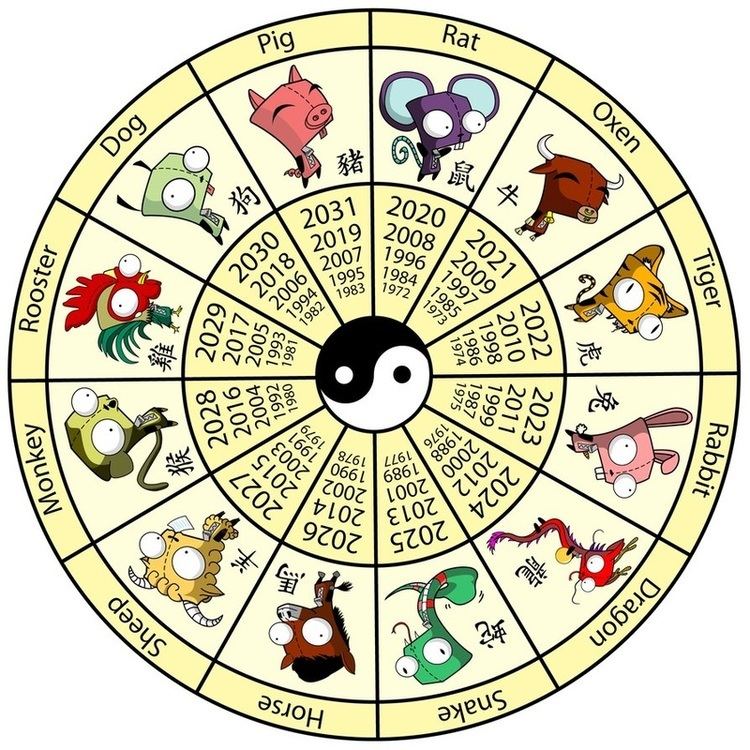 | ||
The myth behind the chinese zodiac megan campisi and pen pen chen
The Chinese zodiac is a classification scheme that assigns an animal and its reputed attributes to each year in a repeating 12-year cycle. The 12-year cycle is an approximation to the 11.86-year orbital period of Jupiter, the largest planet of the solar system. It and its variations remain popular in several East Asian countries including China, Vietnam, Burma, Korea, Japan, Mongolia, Nepal, Bhutan, Sri Lanka, Cambodia, Laos and Thailand as well as the Buddhist calendar.
Contents
- The myth behind the chinese zodiac megan campisi and pen pen chen
- Your fortune 2017 chinese zodiac horoscope predictions
- Name
- Signs
- Years
- Months and solar terms
- Hours
- Day
- Compatibility
- Four Pillars
- Four Animal Trines
- First Trine
- Second Trine
- Third Trine
- Fourth Trine
- Zodiac origin stories
- The Great Race
- Problems with English translation
- Chinese zodiac in other countries
- East Asia
- Bulgars Huns and Turkic people
- Tor calendar
- References
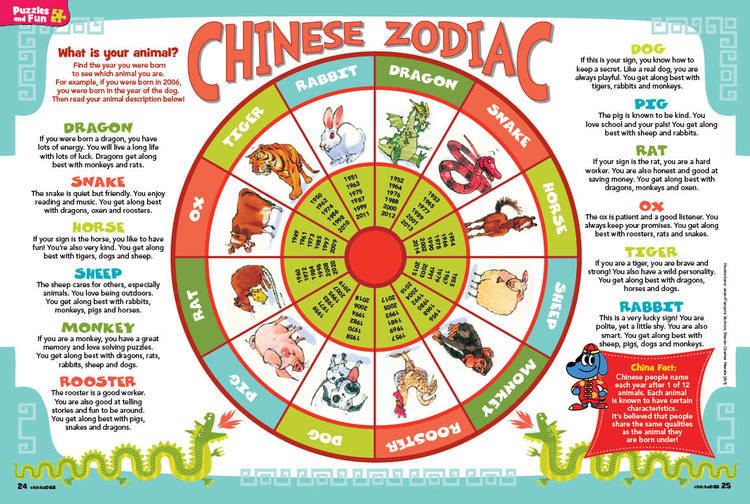
Your fortune 2017 chinese zodiac horoscope predictions
Name
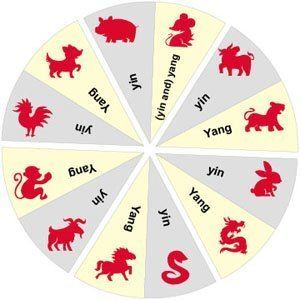
Identifying this scheme using the term "zodiac" reflects several superficial similarities to the Western zodiac: both have time cycles divided into 12 parts, each labels at least the majority of those parts with names of animals, and each is widely associated with a culture of ascribing a person's personality or events in his or her life to the supposed influence of the person's particular relationship to the cycle. Nevertheless, there are major differences: the Chinese 12-part cycle corresponds to years, rather than months. The Chinese zodiac is represented by 12 animals, whereas some of the signs in the Western zodiac are not animals, despite the implication of the Greek etymology of "zodiac". The animals of the Chinese zodiac are not associated with constellations spanned by the ecliptic plane.
Signs
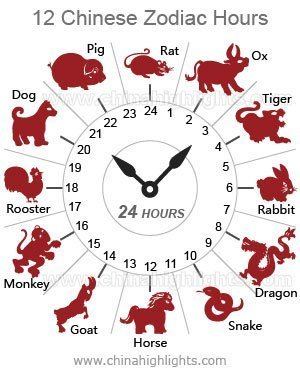
The zodiac traditionally begins with the sign of the Rat. The following are the twelve zodiac signs (each with its associated Earthly Branch) in order and their characteristics.
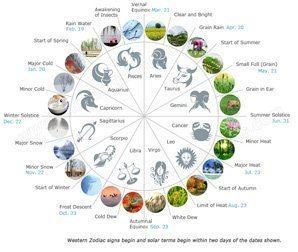
- Rat – 鼠 (子) (Yang, 1st Trine, Fixed Element Water)
- Ox – 牛 (丑) (Yin, 2nd Trine, Fixed Element Earth)
- Tiger – 虎 (寅) (Yang, 3rd Trine, Fixed Element Wood)
- Rabbit – 兔 or 兎 (卯) (Yin, 4th Trine, Fixed Element Wood)
- Dragon – 龍 / 龙 (辰) (Yang, 1st Trine, Fixed Element Earth)
- Snake – 蛇 (巳) (Yin, 2nd Trine, Fixed Element Fire)
- Horse – 馬 / 马 (午) (Yang, 3rd Trine, Fixed Element Fire)
- Goat – 羊 (未) (Yin, 4th Trine, Fixed Element Earth)
- Monkey – 猴 (申) (Yang, 1st Trine, Fixed Element Metal)
- Rooster – 雞 / 鸡 (酉) (Yin, 2nd Trine, Fixed Element Metal)
- Dog – 狗 / 犬 (戌) (Yang, 3rd Trine, Fixed Element Earth)
- Pig – 豬 / 猪 (亥) (Yin, 4th Trine, Fixed Element Water)

In Chinese astrology the animal signs assigned by year represent what others perceive you as being or how you present yourself. It is a common misconception that the animals assigned by year are the only signs and many western descriptions of Chinese astrology draw solely on this system. In fact, there are also animal signs assigned by month (called inner animals), by day (called true animals) and hours (called secret animals).
While a person might appear to be a Dragon because they were born in the year of the Dragon, they might also be a Snake internally, an Ox truly, and a Goat secretively.
A conflict between a person's zodiac sign and how they live is known as tai sui or kai sui.
Years
Within the Four Pillars, the year is the pillar representing information about the person's family background and society or relationship with their grandparents. The person's age can also be easily deduced from the sign of the person, the current sign of the year and the person's perceived age (teens, mid 20's, 40's and so on). For example, a person who is a Tiger is either 12, 24, 36 or 48 years old in 2010, the year of the Tiger. In 2011, the year of the Rabbit, that person is one year older.
The following table shows the 60-year cycle matched up to the Western calendar for the years 1924–2043 (see Sexagenary cycle article for years 1804–2043). The sexagenary cycle begins at lichun 'about February 4' according to some astrological sources.
Months and solar terms
Within the Four Pillars, the month is the pillar representing information about the person's parents or childhood. Many Chinese astrologers consider the month pillar to be the most important one in determining the circumstances of one's adult life.
The 12 animals are also linked to traditional Chinese agricultural calendar, which runs alongside the better known lunar calendar. Instead of months, this calendar is divided into 24 two week segments known as Solar Terms. Each animal is linked to two of these solar terms for a period similar to the Western month. Unlike the 60 year lunar calendar, which can vary by as much as a month in relation to the Western calendar, the agricultural calendar varies by only one day, beginning on the Western February 3 or 4 every year. Again unlike the cycle of the lunar years, which begins with the Rat, the agricultural calendar begins with the Tiger as it is the first animal of spring. Around summer days are longer than winter days, because it occurs differences of perihelion and aphelion.
As each sign is linked to a month of the solar year, it is thereby also linked to a season. Each of the elements is also linked to a season (see above), and the element that shares a season with a sign is known as that sign's fixed element. In other words, that element is believed to impart some of its characteristics to the sign concerned. The fixed element of each sign applies also to the year and hour signs, and not just the monthly sign. It is important to note that the fixed element is separate from the cycle of elements which interact with the signs in the 60-year cycle.
Hours
The Chinese zodiac is also used to label times of the day, with each sign corresponding to a "large-hour" or shichen (時辰), which is a two-hour period (24 divided by 12 animals). Determining this period depends on knowing an individual's exact time of birth. The secret animal is thought to be a person's truest representation, since this animal is determined by the smallest denominator: a person's birth hour. As this sign is based on the position of the sun in the sky and not the time shown on a local clock, followers of this system believe it to be important to compensate for daylight saving time. However, some on-line systems already compensate for daylight saving time, and astrologers may compensate for this as well, even though a client may already have compensated for it, leading to a theoretically inaccurate reading.
Within the Four Pillars, the hour is the pillar representing information about one's children and contributions to the world or later life.
Solar time:
The times above are based on local solar time, rather than standard time. To convert to standard time, one needs to add or take off up to 30 minutes or more, depending on one's birth location west or east respectively of the central meridian of the given time zone. For example, London, marking the central meridian of Greenwich Mean Time, has solar time equivalent to standard time.
Day
4 pillars calculator can determine the zodiac animal of the day.
Chinese animal signs rule over days of the week, too. The term for them is “True Animals.” If your astrologer wishes to prepare a chart, it is essential he or she knows the animals of your day of birth. Given there are only seven days of the week and 12 animals, there is some repetition or doubling up.
The animals for each day are as follows:
Compatibility
As the Chinese zodiac is derived according to the ancient Five Elements Theory, every Chinese Sign is composed of five elements with relations, among those elements, of interpolation, interaction, over-action, and counter-action—believed to be the common law of motions and changes of creatures in the universe. Different people born under each animal sign supposedly have different personalities, and practitioners of Chinese astrology consult such traditional details and compatibilities to offer putative guidance in life or for love and marriage.
Chinese Zodiac Compatibility Grid
Four Pillars
The Four Pillars method can be traced back to the Han Dynasty (201BC – AD 220), and is still much used in Feng Shui astrology and general analysis today. The Four Pillars or Columns chart is called such as the Chinese writing causes it to fall into columns. Each pillar or column contains a stem and a branch—and each column relates to the year, month, day and hour of birth. The first column refers to the year animal and element, the second to the month animal and element, the third to the day animal and element, and the last to the hour animal and element.
Within the 'Four Pillars', the Year column purports to provide information about one's ancestor or early age, and the Month column about one's parents or growing age. The Day column purports to offer information about oneself (upper character) and one's spouse (lower character) or adult age, and the Hour column about children or late age.
Four Animal Trines
See: Astrological aspect#TrineFirst Trine
The first trine consists of the Rat, Dragon and Monkey. These three signs are said to be intense and powerful individuals capable of great good, who make great leaders but are rather unpredictable. The three are said to be intelligent, magnanimous, charismatic, charming, authoritative, confident, eloquent and artistic, but can be manipulative, jealous, selfish, aggressive, vindictive or deceitful.
Second Trine
The second trine consists of the Ox, Snake and Rooster. These three signs are said to possess endurance and application, with slow accumulation of energy, meticulous at planning but tending to hold fixed opinions. The three are said to be hard-working, modest, industrious, loyal, philosophical, patient, good-hearted and morally upright, but can also be self-righteous, egotistical, vain, judgmental, narrow-minded or petty.
Third Trine
The third trine consists of the Tiger, Horse and Dog. These three signs are said to seek true love, to pursue humanitarian causes, to be idealistic and independent but tending to be impulsive. The three are said to be productive, enthusiastic, independent, engaging, dynamic, honorable, loyal and protective, but can also be rash, rebellious, quarrelsome, anxious, disagreeable or stubborn.
Fourth Trine
The fourth trine consists of the Rabbit, Goat and Pig. These three signs are said to have a calm nature and an intellectual approach; they seek aesthetic beauty and are artistic, well-mannered and compassionate, yet detached and resigned to their condition. The three are said to be caring, self-sacrificing, obliging, sensible, creative, empathetic, tactful and prudent, but can also be naïve, pedantic, insecure, cunning, indecisive or pessimistic.
Zodiac origin stories
There are many stories and fables to explain the beginning of the zodiac. Since the Han Dynasty, the 12 Earthly Branches have been used to record the time of day. However, for the sake of entertainment and convenience, they have been replaced by the 12 animals. The 24 hours are divided into 12 periods, and a mnemonic refers to the behaviour of the animals:
A Branch may refer to a double-hour period. In the latter case it is the center of the period; for instance, 马 (the Horse) means noon or a period from 11am to 1pm.
The Great Race
An ancient folk story tells that Cat and Rat were the worst swimmers in the animal kingdom. Although they were poor swimmers, they were both quite intelligent. To get to the meeting called by the Jade Emperor, they had to cross a river to reach the meeting place. The Jade Emperor had also decreed that the years on the calendar would be named for each animal in the order they arrived to the meeting. Cat and Rat decided that the best and fastest way to cross the river was to hop on the back of Ox. Ox, being naïve and good-natured, agreed to carry them both across. Midway across the river, Rat pushed Cat into the water. Then as Ox neared the other side of the river, Rat jumped ahead and reached the shore first, claiming first place in the competition and the zodiac.
Following closely behind was strong Ox, who was named the second animal in the zodiac. After Ox, came Tiger, panting, while explaining to the Jade Emperor how difficult it was to cross the river with the heavy currents pushing it downstream all the time. With its powerful strength, it made it to shore and was named the third animal in the cycle.
Suddenly, from a distance came a thumping sound, and the Rabbit arrived. It explained how it crossed the river: by jumping from one stone to another in a nimble fashion. Halfway through, it almost lost the race, but it was lucky enough to grab hold of a floating log that later washed him to shore. For that, it became the fourth animal in the zodiac cycle. In fifth place was the flying Dragon. The Jade Emperor was deeply curious as to why a swift airborne creature such as the Dragon should fail to reach first place. The mighty Dragon explained that it had to stop and make rain to help all the people and creatures of the earth, and therefore it was held back. Then, on its way to the finish, it saw the helpless Rabbit clinging onto a log so it did a good deed and gave a puff of breath to the poor creature so that it could land on the shore. The Jade Emperor was very pleased with the actions of the Dragon, and it was added into the zodiac cycle. As soon as it had done so, a galloping sound was heard, and the Horse appeared. Hidden on its hoof was the Snake, whose sudden appearance gave it a fright, thus making it fall back and giving the Snake the sixth spot, while the Horse placed seventh.
Not long after, the Goat, Monkey, and Rooster came to the shore. The three creatures helped each other to get to the shore. The Rooster spotted a raft, and took the other two animals with it. Together, the Goat and the Monkey cleared the weeds, tugged and pulled and finally got the raft to the shore. Because of their combined efforts, the Emperor was very pleased and promptly named the Goat as the eighth creature, the Monkey as the ninth, and the Rooster the tenth.
The eleventh animal was the Dog. Although it was supposed to be the best swimmer, it could not resist the temptation to play a little longer in the river. Though his explanation for being late was because it needed a good bath after a long spell. For that, it almost did not make it to the finish line. Just as the Jade Emperor was about to call it a day, an oink and squeal was heard from a little Pig. It got hungry during the race, promptly stopped for a feast and then fell asleep. After the nap, it continued the race and was named the twelfth animal of the zodiac cycle. The cat eventually drowned, and did not make it in the zodiac. It is said that this is the reason cats always chase Rats.
Another folk story tells that the Rat deceived the Ox into letting it jump on its back, in order for the Ox to hear the Rat sing, before jumping off at the finish line and finishing first.
In Buddhism, legend has it that Buddha summoned all of the animals of the earth to come before him before his departure from this earth, but only 12 animals actually came to bid him farewell. To reward the animals who came to him, he named a year after each of them. The years were given to them in the order they had arrived.
The twelve animals of the Chinese zodiac were developed in the early stages of Chinese civilization, over hundreds of years before it developed into the current version; it is difficult to investigate its real origins. Most historians agree that the cat is not included, as they had not yet been introduced to China from India, with the arrival of Buddhism.
Problems with English translation
Due to confusion with synonyms during translation, some of the animals depicted by the English words did not exist in ancient China. For example, 羊 can mean ram, sheep or Goat. Similarly, 鼠 (Rat) can also be translated as mouse, as there are no distinctive words for the two genera in Chinese. Further, 豬 (Pig) is sometimes translated to boar after its Japanese name, and 牛 plainly means cow or Ox, and not water buffalo, 水牛. 雞 (Rooster) may mean chicken or cock. However, Rooster is the most commonly used one among all the synonyms, same for 羊, 鼠, etc.
Chinese zodiac in other countries
The Chinese zodiac signs are also used by cultures other than Chinese. For one example, they usually appear on Korean New Year and Japanese New Year's cards and stamps. The United States Postal Service and those of several other countries issue a "Year of the ____" postage stamp each year to honor this Chinese heritage.
The Chinese lunar coins, depicting the zodiac animals, inspired the Canadian Silver Maple Leaf coins, as well as varieties from Australia, Korea, and Mongolia. The Chinese zodiac is an internationally popular theme, available from many of the world's government and private mints.
The Chinese zodiac is also used in some other Asian countries that have been under the cultural influence of China. However, some of the animals in the zodiac may differ by country.
East Asia
The Korean zodiac is almost identical to the Chinese zodiac except it includes the Sheep instead of the Goat. The Vietnamese zodiac is almost identical to the Chinese zodiac except the second animal is the Water Buffalo instead of the Ox, and the fourth animal is the Cat instead of the Rabbit. The Japanese zodiac includes the Sheep instead of the Goat, and the Wild Boar instead of the Pig. The Japanese have, since 1873, celebrated the beginning of the new year on 1 January as per the Gregorian Calendar. The Thai zodiac includes a nāga in place of the Dragon and begins, not at Chinese New Year, but either on the first day of fifth month in Thai lunar calendar, or during the Songkran festival (now celebrated every 13–15 April), depending on the purpose of the use.
Bulgars, Huns and Turkic people
The European Huns used the Chinese zodiac complete with "Dragon" "Pig". This common Chinese-Turkic Zodiac was in use in Balkan Bulgaria well into the Bulgars' adoption of Slavic language and Orthodox Christianity. Following is the Hunnish or Bulgarian Pagan zodiac calendar, distinctive from the Greek zodiac but much in conformity with the Chinese one:
Torè calendar
Names of years
- Kuzgé – [Year of] Saravana - Rat
- Shiger (Syger) – Ox
- Kuman (Imén)
- Ügur – Tiger, Myachè Ügur – Tiger
- Taushan – Rabbit
- Samar – Dragon Birgün (Bergen, Birig, Baradj) – Dragon
- Dilan – Snake
- Tykha – Horse
- Téké – Goat
- Bichin, Michin – Monkey
- Tavuk – Rooster (also written tağuk—ğ is pronounced as v in Turk. verbs döğmek and öğmek)
- It – Dog
- Shushma – Pig (many mistake it as boar though)(Turk., Russ. "Kaban"—Translator's Note, also cognate of Turkish şişman, "fat")
In Kazakhstan, an animal cycle similar to the Chinese is used, but the Dragon is substituted by a snail (Kazakh: улу), and Tiger appears as a leopard (Kazakh: барыс).
In Mongolia 12 year beasts are called "Арван хоёр жил" meaning "12 years"
- Hulgana - Хулгана - Rat
- Ukher - Үхэр - Ox
- Bar - Бар - Tiger
- Tuulai - Туулай - Rabbit
- Luu - Луу - Dragon
- Mogoi - Могой - Snake
- Mori - Морь - Horse
- Honi - Хонь - Goat
- Bichin, Michin, Mechin - Бич/Мич, Бичин, Мичин, Мэчин - Monkey
- Tahiya - Тахиа - Rooster
- Nohoi - Нохой - Dog
- Gahai - Гахай - Pig
